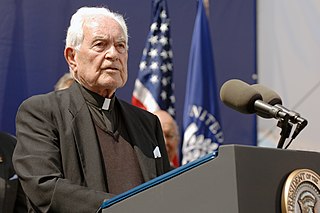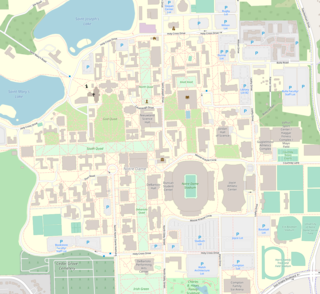
The University of Notre Dame du Lac, known simply as Notre Dame, is a private Catholic research university in Notre Dame, Indiana, north of the city of South Bend. French priest Edward Sorin founded the school in 1842. The main campus covers 1,261 acres in a suburban setting and contains landmarks such as the Golden Dome, the Word of Life mural, Notre Dame Stadium, and the Basilica. Originally for men, the university started accepting undergraduate women in 1972.

Rev. Theodore Martin Hesburgh, CSC was an American Catholic priest and academic who was a member of the Congregation of Holy Cross. He is best known for his service as the president of the University of Notre Dame for thirty-five years (1952–1987). In addition to his career as an educator and author, Hesburgh was a public servant and social activist involved in numerous American civic and governmental initiatives, commissions, international humanitarian projects, and papal assignments. Hesburgh received numerous honors and awards for his service, most notably the United States's Presidential Medal of Freedom (1964) and Congressional Gold Medal (2000). As of 2013, he also held the world's record for the individual with most honorary degrees with more than 150.

O'Dea High School is a Catholic all boys high school founded in 1923 and is located in Seattle's First Hill neighborhood. The school is named after Edward John O'Dea who was bishop of Seattle when the school was built. O'Dea is a part of the Archdiocese of Seattle.

Gonzaga College High School is a private Catholic college-preparatory high school for boys in Washington, D.C. Founded by the Jesuits in 1821 as the Washington Seminary, Gonzaga is named in honor of Aloysius Gonzaga, an Italian saint from the 16th century. Gonzaga is the oldest boys' high school in the District of Columbia.

Loyola High School is a co-ed subsidized private Catholic school for grades 7–11 located in the Loyola District of the Côte-des-Neiges–Notre-Dame-de-Grâce borough in Montreal, Quebec, Canada. It was established in 1896 by the Society of Jesus as part of Loyola College, at the request of the English Catholic community in Montreal. It is named after St. Ignatius of Loyola, who founded the Jesuit Order in 1534.

Reverend Fr. Stephen Theodore Badin was the first Catholic priest ordained in the United States. He spent most of his long career ministering to widely dispersed Catholics in Canada and in what became the states of Kentucky, Ohio, Indiana, Michigan, and Illinois.
Rev. Edward Aloysius Malloy, C.S.C., is an American Catholic priest, academic, and former college basketball player who is a member of the Congregation of Holy Cross. Nicknamed “Monk Malloy”, he is best known for his service as the 16th president of the University of Notre Dame from 1987 to 2005.
Ex corde Ecclesiae is an apostolic constitution issued by Pope John Paul II regarding Catholic colleges and universities. Promulgated on 15 August 1990 and intended to become effective in the academic year starting in 1991, its aim was to define and refine the Catholicism of Catholic institutions of higher education.

Badin Hall is one of the 32 Residence Halls on the campus of the University of Notre Dame and one of the 14 female dorms. The smallest residence hall on campus, it is located on South Quad, between Howard Hall and the Coleman-Morse center. It was built in 1897 and hosted the Manual Labor School until 1917 before being converted into a men's dorm. During World War II, it was part of the United States Naval Reserve Midshipmen's School, and in 1972 it became one of the first two residence halls at Notre Dame to host women.
The Milltown Institute of Theology and Philosophy was a Jesuit-run institution of higher education and research, located in Dublin, Ireland. It was located in Ranelagh, County Dublin.

Theodore Hesburgh Library is the primary building of the University of Notre Dame's library system. The present-day building opened on September 18, 1963, as Memorial Library. In 1987, it was renamed Hesburgh Library, in honor of Rev. Theodore Hesburgh, C.S.C., who served as the university's president from 1952 to 1987. The library's exterior façade that faces the university's football stadium includes a large, 134-foot (41 m) by 68-foot (21 m) mural called Word of Life, or more commonly known as Touchdown Jesus. As of 2009, the library ranked as the 61st largest collection among research universities in the United States, with an estimated 3.39 million volumes.

The University of Notre Dame was founded on November 26, 1842, by Father Edward Sorin, CSC, who was also its first president, as an all-male institution on land donated by the Bishop of Vincennes. Today, many Holy Cross priests continue to work for the university, including as its president. Notre Dame rose to national prominence in the early 1900s for its Fighting Irish football team, especially under the guidance of the legendary coach Knute Rockne. Major improvements to the university occurred during the administration of Rev. Theodore Hesburgh between 1952 and 1987 as Hesburgh's administration greatly increased the university's resources, academic programs, and reputation and first enrolled women undergraduates in 1972.
Charles E. Sheedy, C.S.C. was an American priest and theologian of the Congregation of Holy Cross and an administrator at the University of Notre Dame.
The History of Catholic Education in the United States extends from the early colonial era in Louisiana and Maryland to the parochial school system set up in most parishes in the 19th century, to hundreds of colleges, all down to the present.

The campus of the University of Notre Dame is located in Notre Dame, Indiana, and spans 1,250 acres comprising around 170 buildings. The campus is consistently ranked and admired as one of the most beautiful university campuses in the United States and around the world, particularly noted for the Golden Dome, the Basilica and its stained glass windows, the quads and the greenery, the Grotto, Touchdown Jesus, its collegiate gothic architecture, and its statues and museums. Notre Dame is a major tourist attraction in northern Indiana; in the 2015–2016 academic year, more than 1.8 million visitors, almost half of whom were from outside of St. Joseph County, visited the campus.

Hesburgh is a 2018 American documentary film directed by Patrick Creadon. The film follows the life of Fr. Theodore Hesburgh, President of the University of Notre Dame from 1952 through 1987, particularly during his time working on the U.S. Commission on Civil Rights. The film is drawn from archival footage, as well as interviews with family, colleagues at Notre Dame, politicians, journalists, and historians. Maurice LaMarche provides the voice of Hesburgh, narrating the documentary with words drawn from Hesburgh's writings and tapes.

Edward Bernard Foley, OFM Cap. is a Catholic priest, educator, preacher, theologian and author, and a member of the Capuchin Franciscan Order. He is also the Duns Scotus Professor Emeritus of Spirituality and Professor of Liturgy and Music at Catholic Theological Union, where he was the founding director of the Ecumenical Doctor of Ministry Program.
The Land O'Lakes Statement of 1967 was an influential manifesto published in Land o' Lakes, Wisconsin, about Catholic higher education in the United States. Inspired by the liberalization represented by the Second Vatican Council, it charted a course for intellectual freedom and autonomy for Catholic universities. The statement declared that "To perform its teaching and research functions effectively the Catholic university must have a true autonomy and academic freedom in the face of authority of whatever kind, lay or clerical, external to the academic community itself." In the next few decades hundreds of Catholic schools kept the religious designation but began to operate independent of the Catholic Church with its bishops and papacy.
George Nauman Shuster was an American journalist, author, and educator who was born in Lancaster, Wisconsin in 1894 and died in South Bend, Indiana, on January 25, 1977. Born into German ethnic community, he attended Catholic schools and earned his A.B. degree at the University of Notre Dame in 1915. He served in Army intelligence during World War I. After that he studied at the universities of Poitiers and Berlin. He took a PhD in English literature at Columbia University. He was head of the English department at Notre Dame (1920–24); he taught English at Brooklyn Polytechnic Institute and St. Joseph's College for Women in Brooklyn. (1924–34).











